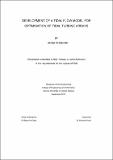| dc.description.abstract | Tidal current turbines have the potential to provide a proportion of global energy requirements. Installations to date have been singular test devices but commercial application will involve multiple devices deployed in farms. The viability of large-scale tidal turbine arrays will depend on the expected energy yield of the farm and the associated hydro-environmental impacts. The effects are, as yet, still relatively unknown although numerical models have been used to show that they can be significant.
In this study a 2D hydrodynamic tidal flow model has been developed to facilitate the modelling of tidal turbine arrays so that one can determine an optimum array layout with regard to both power capture and hydrodynamic impacts. This involved a number of model development stages to facilitate (1) calculation of the available resource, (2) simulation of energy extraction, (3) power quantification and (4) implementation of the array optimisation algorithm.
The first model development stage was to establish and implement a methodology which accurately quantifies available resource. This research is based on horizontal axis turbines, whose fixed orientation results in maximum energy extraction occurring when flow is travelling perpendicular to the turbine swept area. The methodology therefore utilises harmonic and ellipse analyses to determine the primary direction of current flow at a site, which is then used to quantify available power. This results in a higher degree of sophistication compared to traditional approaches which are based on the total velocity vector.
The tidal flow model was next developed to enable simulation of tidal energy extraction via the momentum sink approach. This requires parameterisation of the turbine thrust coefficient which is theoretically defined based on the undisturbed velocity upstream of a turbine but is usually calculated using the local velocity at the turbine. A sensitivity analysis concluded that if calculation of the thrust is based on localised current velocities it is necessary to specify a localised thrust coefficient. Based on this finding, a thrust coefficient chart has been developed from which suitable localised thrust coefficients can be determined based on the turbine grid cell blockage ratio for a particular model grid cell. The third stage of development involved incorporating a power quantification calculation into the energy extraction model. The power extracted by an individual turbine is based on the model-calculated turbine thrust.
The final stage of model development involved developing an optimisation algorithm which determines an optimal array configuration for maximum energy capture whilst employing spatial and environmental impact constraints. This algorithm was incorporated into the numerical model and application of the fully developed model to test cases demonstrated that optimal arrays should be staggered, thereby producing higher efficiencies than symmetrical inline arrays.
This is the first optimisation model to relate hydro-environmental impacts to the level of energy extraction. The fully developed model could be extremely useful for determining the economic viability of proposed arrays, enabling determination of environmentally-safe levels of tidal energy extraction, and completion of a realistic and accurate cost-benefit analysis for early stage tidal energy projects. It is therefore, potentially, a very valuable tool for tidal energy researchers and turbine developers. | en_IE |


